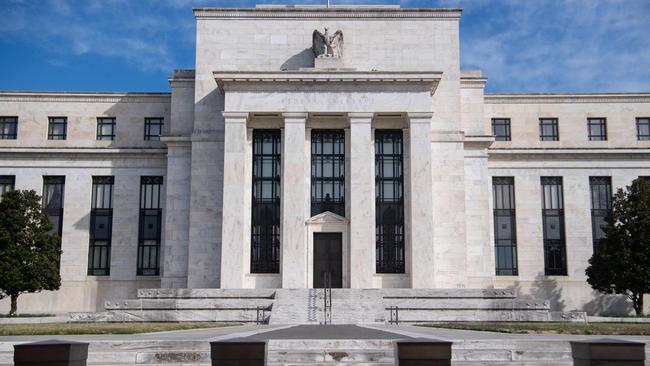Fed signals half-percentage-point increases could be warranted at coming meetings
Minutes from the Federal Reserve meeting revealed officials strongly weighed raising rates by 50 basis points as well as shrinking the balanace sheet to tame inflation.

Federal Reserve officials last month strongly considered raising rates by a half-percentage point and neared agreement on a plan to reduce their bondholdings as part of their most aggressive effort in years to curb price pressures.
Officials last month approved their first interest rate increase in more than three years, raising their benchmark rate by a quarter percentage point to a range between 0.25 per cent and 0.5 per cent. They also pencilled in a series of additional rate increases this year to take rates closer to 2 per cent, amid inflation that has surged to a four-decade high.
The minutes revealed that many officials would have preferred a larger half-point rate increase at that meeting but judged a smaller quarter-point increase would be appropriate “in light of greater near-term uncertainty associated with Russia’s invasion of Ukraine,” said minutes of the March 15-16 meeting, released Wednesday with a customary three-week lag.
“Many participants noted that one or more [half-percentage-point] increases in the target range could be appropriate at future meetings, particularly if inflation pressures remained elevated or intensified,” the minutes said.
The minutes revealed for the first time how officials expect to shrink their asset holdings much more rapidly than they did last decade, which would serve as another key tool for tightening monetary policy.
Expectations of a much more aggressive Fed tightening process has already led to a sharp sell-off this year in bonds. The yield on the benchmark 10-year Treasury note, which rises when bond prices fall, rose to 2.554 per cent Tuesday, a three-year high, when Fed governor Lael Brainard hinted at the run-off plans. Yields climbed higher, to 2.6 per cent on Wednesday afternoon, before the release of the minutes.
The Fed’s plans have sent tremors through the mortgage market, where the average 30-year fixed-rate mortgage rose to 4.9 per cent last week, the highest rate since late 2018, according to the Mortgage Bankers Association.
In the three weeks since they last met, many Fed officials have indicated they could support raising rates by a half percentage point instead of the traditional quarter point at their coming meeting on May 3-4.
In a speech after last month’s Fed meeting, Chairman Jerome Powell suggested the central bank was prepared to raise rates in half-point increments this spring and summer, if necessary.
Inflation rose to 6.4 per cent in February from a year earlier, according to the Fed’s preferred gauge, the Commerce Department’s personal-consumption expenditures price index. Core inflation, which excludes food and energy prices, rose 5.4 per cent. Those readings were near their highest in four decades.
Fed officials initially anticipated one year ago that surging prices of goods would prove short lived, and they described higher inflation as transitory. They backed away from that characterisation last fall, as the labour market healed rapidly and price pressures broadened to a wider range of goods and, more important, labour-intensive services.
Still, the Fed as recently as January had expected inflation to diminish this spring as supply-chain bottlenecks improved. The war in Ukraine and potential lockdowns in China to deal with more contagious variants of the coronavirus have ended any expectation of near-term relief from a healing supply chain.
“That story has already fallen apart,” Mr Powell said on March 21. “To the extent it continues to fall apart, my colleagues and I may well reach the conclusion we’ll need to move more quickly. And if so, we’ll do so.” The central bank is still counting on inflation falling later this year as supply chains heal and as more workers return to labour markets. But in contrast with the Fed’s patient stance through much of 2021, as inflation surged, Mr Powell said the central bank could no longer set policy by forecasting that such relief would materialise.
“As we set policy, we will be looking to actual progress on these issues and not assuming significant near-term supply-side relief,” he said.
Fed officials also appear close to approving a plan to shrink their asset portfolio, which nearly doubled over the last two years. Officials agreed that they were “well placed to begin the process of reducing the size of the balance sheet as early as after the conclusion of its upcoming meeting in May,” the minutes said.
The Fed bought nearly $US1.5 trillion in government debt in March and April 2020 to prevent a broader financial meltdown and then continued to buy $US120 billion a month in Treasury and mortgage-backed securities until last fall to provide additional stimulus to the economy by lowering long-term interest rates.
The Fed phased out those purchases one month ago and has been reinvesting the proceeds of maturing securities into new ones. It owns $5.76 trillion in Treasury securities, or 24 per cent of that market, and $US2.72 trillion in mortgage bonds issued by government-related entities, or around 31 per cent of that market.
Officials agreed last month to follow a template similar to the one they used when they shrank their asset holdings between late 2017 and mid-2019, in which they allowed a fixed amount of securities to run off the portfolio every month without being reinvested.
The minutes showed officials discussed allowing up to $US95bn in securities to mature every month – $US60bn in Treasurys and $US35bn in mortgage bonds. That would allow the portfolio to run off considerably faster this time than last decade, when it shrunk by $US800bn, to $US3.7 trillion in 2019.
Also, unlike during the previous portfolio run-off, the Fed owns more than $US326bn in short-term Treasury bills. The minutes indicated officials would allow coupon-bearing securities to mature first, and in months in which fewer than $US60bn in such securities mature, the central bank would then redeem Treasury bills.
The Fed discussed phasing in those redemption caps over a period of “three months or modestly longer if market conditions warrant,” the minutes said. Officials discussed plans to actively sell mortgage-backed securities at a later date to more quickly return their holdings to an all-Treasurys portfolio.
During the run-off last decade, the Fed phased in the process much more gradually over 12 months, and it ultimately never allowed more than $US50bn in securities to mature in any month. Large Wall Street firms surveyed by the New York Fed in January anticipated that the Fed this time would ultimately allow the holdings to decline by $US80bn every month, on average.
Officials have long said that it is easier for them to communicate their policy moves by raising or lowering interest rates rather than by changing the speed at which the portfolio grows or shrinks, meaning they want the run-off program to run in the background.
That is the case in part because there is little consensus within financial and central-banking circles over how reductions in the Fed’s bondholdings will affect interest rates and economic conditions. At a news conference last month, Mr Powell said the portfolio run-off might provide the equivalent of another quarter-percentage-point rate increase this year.
Fed officials face a difficult balancing act because they are attempting to prevent demand from strengthening further, and they could eventually try to deliberately reduce economic growth to slow inflation. But it takes time for their policy steps to influence the economy, creating a risk that they will tip the economy into a recession.
Already, the Fed’s moves are rippling through markets. US bonds had their worst quarter in more than 40 years during the January-to-March quarter. Yields on short- to medium-term Treasurys have logged their biggest quarterly jumps in decades, with the two-year yield rising the most since 1984 and the five-year yield the most since 1987.
The housing market could be an early case study of the Fed’s rapid pivot. Rising interest rates rob buyers of their purchasing power. A general rule of thumb holds that a one-percentage-point rise in interest rates is equivalent to a 10 per cent increase in the costs of purchasing a home.
In Las Vegas, there were 2,000 homes listed for sale without any offer at the end of March, a 13 per cent increase in such listings from the same time last year, according to a report from a local real-estate association released Wednesday.
The Wall Street Journal


